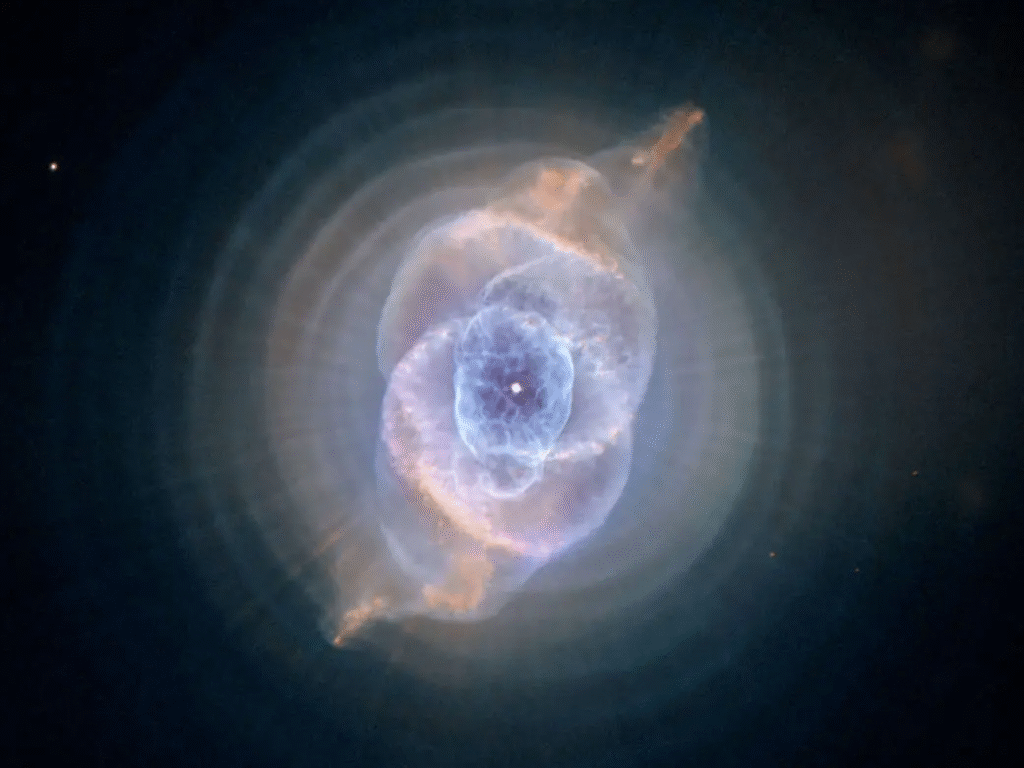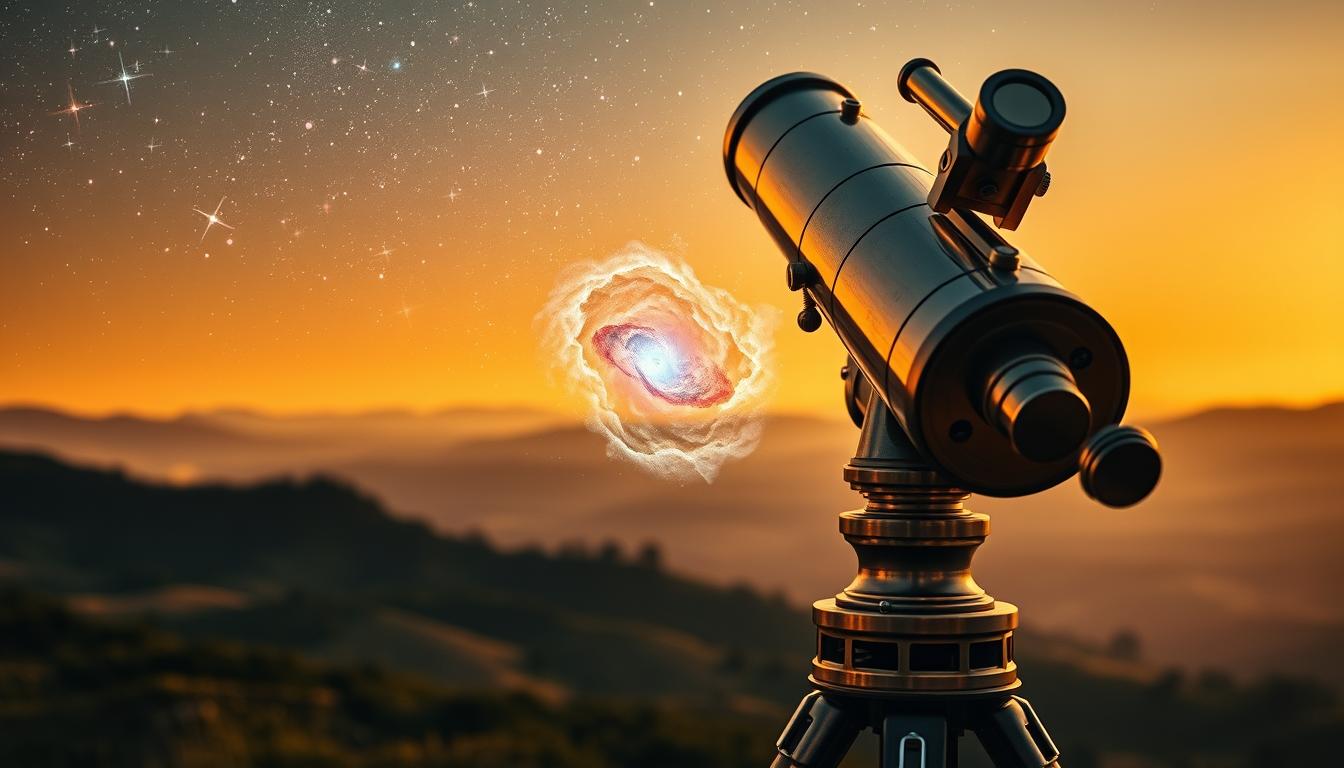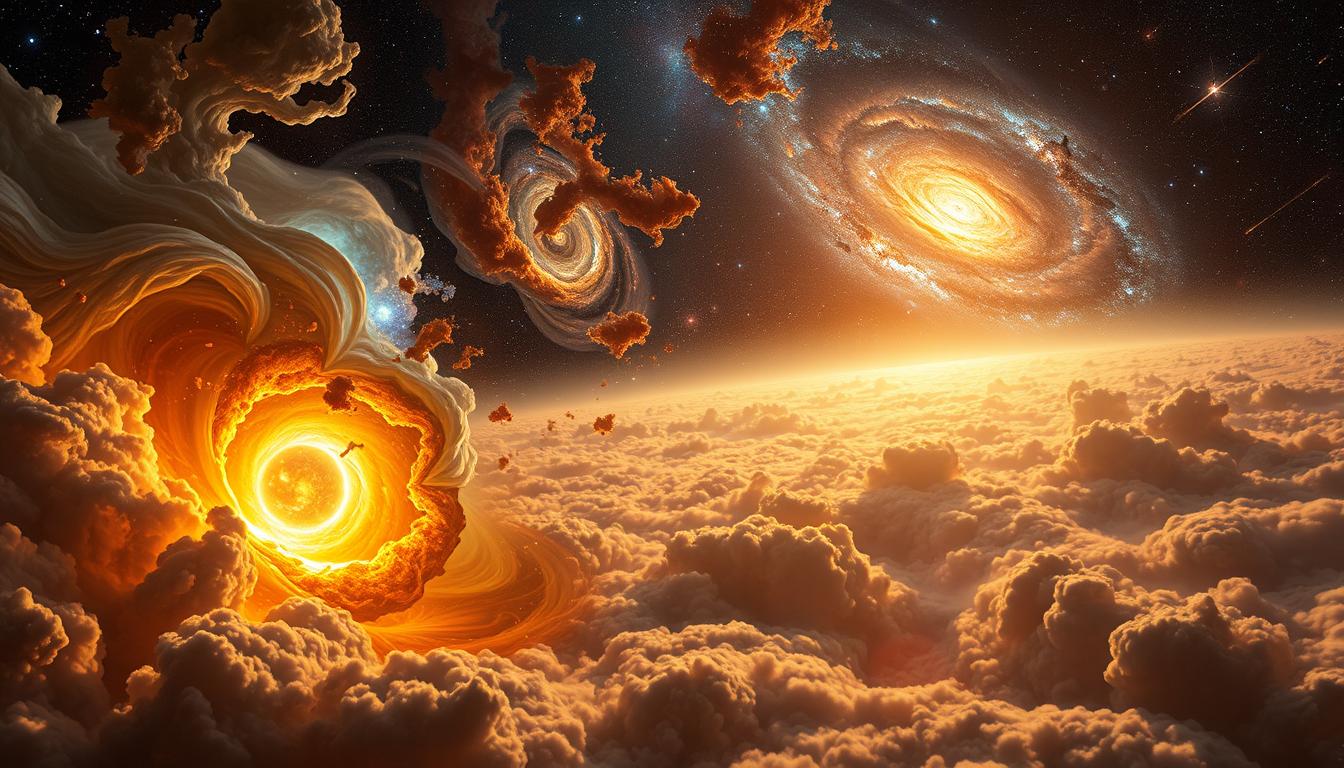When a medium-sized star like our Sun gets old and dies, it sheds its outer layers in a glowing gas. We call that gas, planetary nebula and yes it has nothing to do with planets. Why do we call it that, and what is a planetary nebula? Is it just that gas? Well, not really. There is a history behind the name and the entire formation of a planetary nebula. The real reason is that early astronomers named this nebula like this because it had a planet-like appearance in the telescopes.
Check this article out, too: Are Wormholes Real? Separating Fact from Fiction
When a star reaches the end of its life, it expels layers of gas into space. The exposed hot core ionizes this gas, which creates a stunning, glowing shell. These formations, like the Cat’s Eye Nebula or the Southern Ring Nebula have short life span but breathtaking.
We kept the term planetary nebula, and it’s a good reminder of how cosmology evolves so fast. So, what is a planetary nebula? They are an amazing source of information for understanding the life cycle of stars and what’s left when some of them are gone.

Introduction to Planetary Nebulae
Stars don’t just fade when they are dying; they leave behind glowing gases. They often mistaked these objects for planets in the past through telescopes. But they are the result of stellar evolution. When a star exhausts its fuel, it sheds its outer layers and creates a luminous shell of gas. So they don’t have anything to do with planets, and they don’t create planets. It’s just a nickname left from ancient times (I will get back to it below). At the heart of this glowing shell, there is the central star that died. This hot core emits ultraviolet radiation, ionizing the surrounding material. The result is a breathtaking display of colors and shapes that we can see on our computers nowadays.
What is a Planetary Nebula?
The term ‘planetary nebula’ is a misnomer that has stuck since the beginning of astronomy with telescopes. Weirdly enough, we didn’t try to change it, either. A planetary nebula is basically what’s left from a dying star.
Imagine a star the size of our Sun reaching the end of its fuel supply. When such a star exhausts its hydrogen fuel, it expands into a red giant. Then, it starts peeling off its outer layers in stages, ejecting them into space. The hot core that’s left behind emits ultraviolet radiation, which lights up the ejected gas and causes it to glow. Those layers continue to be lit by that hot core, and they expand into space and create a colorful, glowing bubble. That bubble is the planetary nebula. It’s not a planet, not even close, but it is a dazzling sign that a star has entered retirement.
The ejected material consists mostly of gas, with temperatures ranging from 10,000 to 20,000 Kelvin. Sometimes, this material forms a disk-like structure, adding to the nebula’s unique appearance. We can use these formations to understand the whole life cycle of star formation, so it’s not just pretty pictures. The core left behind becomes a white dwarf, just chilling there in the middle, slowly cooling off. So if you’ve seen images of glowing rings or cosmic jellyfish floating in deep space, that’s probably a planetary nebula.
Historical Misconceptions and Nomenclature
Let’s talk about one of the worst naming in astronomy. In the late 18th century, astronomers like William Herschel and Antoine Darquier de Pellepoix observed these glowing objects. Through their telescopes, the round, disk-like shapes looked like planets. Naturally, they named these objects something to do with planets. At the time, the tools and knowledge were limited. We didn’t know the true nature of these objects, expelled layers of gas from dying stars. Even though science has long since cleared up what these objects actually are, the name remains because science hates throwing out tradition.

Formation and Life Cycle of Planetary Nebulae
I’ve briefly mentioned how a planetary nebula forms, but there is a deeper formation process behind that, from when the star explodes. It’s a journey from a red giant to a glowing ring, clouds, and more that takes thousands of years. Now that you know what a planetary nebula is from the brief descriptions, the time has come to discuss those details.
From Red Giant to Nebula
The journey starts when a star like our Sun runs out of hydrogen fuel in its core. When this happens, the core contracts under gravity, and the outer layers puff up like a balloon. That’s when the star becomes a red giant. It’s massive, unstable, and starts to lose its grip.
As the star runs out of hydrogen and puffs up, the outer layers drift into space. The outer layer drifts off for thousands (or millions) of years and expands. This material forms a shell around the star, and that becomes a bright ring. Now, the central core is exposed, and it heats up and emits intense ultraviolet radiation. This energy ionizes the surrounding gas, creating the vibrant colors we observe. It’s like a star throwing away all its baggage before a final journey (into becoming a white dwarf), and that baggage is staying there, being beautiful.
The Ring Nebula is a perfect example of this process. Its distinct ring-like structure shows the intricate beauty of stellar evolution. Observations from the Hubble Space Telescope show these detailed layers of gas.

Ionization and Ultraviolet Radiation
Once the outer layers have drifted away, the leftover core starts emitting ultraviolet radiation. It’s super hot, a couple hundred thousand degrees Celsius hot. Now, this ultraviolet radiation causes the gas that was thrown away to glow because the radiation energizes it. This is the visible, beautiful structure we see. That’s why the radiation the star gives away is important in creating the appearance of a nebula. Many of these formations, like the Cat’s Eye Nebula, have these ring features. These rings are a result of the interaction between the star’s radiation and the expelled material. Despite their beauty, they die young, lasting only a few thousand years.
Spectral Analysis and Emission Properties
We’ve talked about the who and the how. It’s now time for the last bit, the what. Specifically, what kind of light planetary nebulae give off, and how astronomers use that light to understand what’s going on. How do we decode those secrets? Spectral analysis is the key. It involves studying the emission lines from these formations. The emissions are great because we can study their composition, temperature, and density.
Key Spectral Features
These glowing structures emit unique emission lines that set them apart. They emit light at specific wavelengths, which show up as bright lines in a spectrum. For example, hydrogen and oxygen lines dominate their spectra, which creates vibrant colors. Each element gives off a kind of cosmic fingerprint, and by reading those fingerprints, scientists can tell what the nebula is made of, how hot it is, and even how fast it’s expanding. Some of the strongest lines come from doubly ionized oxygen, which is why so many nebulae glow in shades of green and blue.
Understanding Forbidden Lines
One of the most fascinating discoveries in spectral analysis is forbidden lines. William Huggins first observed these lines. They happen in low-density gases, and it’s really rare that they happen randomly, in random conditions. They’re called “forbidden” because of that. It’s rare in normal conditions but pretty common in these nebulae. These lines are critical for figuring out the nebula’s physical conditions, such as temperature, density, and ionization levels.
Morphological Diversity and Cosmic Structures
All planetary nebula looks different. Their shapes depend on many things, from the type of star before it died to the age of the star. Anything can affect. We use these shapes to understand the star at the core of the nebula and learn about the formation of these nebulae.
At first glance, some planetary nebulae are simple, round blobs. These spherical nebulae usually come from stars that lived fairly quiet lives. About 26% of these formations are spherical, with smooth, symmetrical shells. Another 61% are elliptical, stretching into elongated shapes. The remaining 13% are bipolar, featuring two distinct lobes. The Butterfly Nebula is a prime example of this striking form.
These shapes are influenced by the way the outer layer is expelled. Spherical forms often happen because of a uniform ejection. Bipolar structures are shaped by jets of material. The role of helium in ionizing the gas also plays a part in defining the final appearance.
Filamentary Details and Surface Features
Zoom in on a planetary nebula, and things get even more different. Many have intricate filaments, knots, or bubbles within their structure. These small-scale features come from instabilities in the gas, interactions with stellar winds, or leftover shockwaves from the star’s previous outbursts. For instance, the outer layer of a dying star can fragment into clumps, creating these textures.
Influence of Binary Stars and Magnetic Fields
If the dying star had a partner—a binary companion—then the whole formation gets way more complex. The gravitational interaction between the two stars can twist, flatten, or even spiral the gas ejection into strange patterns. An example is the Hb 12 nebula, where magnetic fields have created distinct lobes. If you add in magnetic fields, you’ve got even more shaping power. Magnetic fields can channel the outflow of gas, control how the ionized particles move, and stretch or constrain certain features. So while it may look like random space art, there’s often a very magnetic, very binary reason behind the madness.

Impact on Galactic Chemical Enrichment
Now that you know what is a planetary nebula, did you consider how they may affect the rest of the universe? Shape of the galaxy? Its future? It does have a considerable effect because of all the heavier elements it releases. The heavy elements a dying star gives out become part of the interstellar medium. Millions of years later, they can gather and be part of what exists in the universe, even a piece of us humans.
The stuff stars throw out during their final phases helps astronomers track stellar evolution. By analyzing the chemical composition of planetary nebulae, we can tell how much metal a star produced during its lifetime. (In astronomy, “metal” means anything heavier than helium. So yes, carbon is a metal here.) Metallicity affects everything from how a star lives and dies to what kind of planets it can form.
The life cycle of a star directly influences the galaxy’s metallicity, the abundance of elements heavier than hydrogen and helium. As stars die, they release these elements into the interstellar medium, increasing the overall metallicity of the galaxy. Stars that form from this enriched material generally have higher metallicity. The amount of metallicity affects the structure, lifespan, and even the formation of planetary systems.
Contributions to the Interstellar Medium
When a star reaches the end of its life, it expels a shell of gas rich in elements like carbon, nitrogen, and oxygen. As you can imagine, introducing new elements or more elements to what’s already there can cause significant changes to the new environment. In this case, these elements become the building blocks for new stars and planets.
Conclusion
Understanding what is a planetary nebula is both easy and complicated. In short, it’s a cloud of gas that was sent out into the universe from a dying star. But when you look at it deeply, the process of a dying star can tell a long story. From how it died to which elements it released into the universe, we can create different stories. They help us understand how stars form and die, mainly from which elements they spread out and the shape of the nebula.
But one thing is clear: planetary nebula has nothing to do with planets. It has everything to do with stars, specifically white dwarfs. They also look extremely beautiful, no matter the shape. That’s generally the first reason why most people wonder what is a planetary nebula. After seeing all those beautiful pictures, you have to ask.
FAQ
Why are they called planetary nebulae?
Early astronomers thought these glowing objects resembled planets due to their round, disk-like appearance when viewed through telescopes. The name stuck, even though we now know they have no connection to planets.
How does a star create a planetary nebula?
When a star exhausts its nuclear fuel, it sheds its outer layers of gas. The remaining core emits intense ultraviolet radiation, which ionizes the ejected material, causing it to glow and form the nebula.
What elements are commonly found in planetary nebulae?
These cosmic structures are rich in hydrogen and helium. There are also heavier elements like carbon, nitrogen, and oxygen. They are generally created in the star’s core during its life cycle.
How long do planetary nebulae last?
These glowing shells of gas typically remain visible for about 10,000 to 20,000 years before losing their light and enriching the surrounding area with new elements.
Can we see planetary nebulae from Earth?
Yes! Famous examples like the Ring Nebula (M57) and the Helix Nebula are visible through amateur telescopes, offering stunning views of these cosmic phenomena.